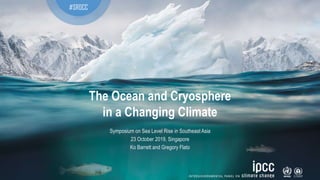The Ocean and Cryosphere in a Changing Climate
- 1. The Ocean and Cryosphere in a Changing Climate #SROCC Symposium on Sea Level Rise in Southeast Asia 23 October 2019, Singapore Ko Barrett and Gregory Flato
- 2. The worldŌĆÖs ocean and cryosphere have been ŌĆśtaking the heatŌĆÖ from climate change for decades. Consequences for nature and humanity are sweeping and severe.
- 3. High Mountains Polar Regions Ocean and Marine LifePhoto: Mr. JK Ocean & Marine Life Sea Level Rise
- 4. Photo: Glenn R. Specht Sea Level Rise
- 5. ŌĆó Greenland and Antarctic ice sheets are melting, and are now the major cause of accelerating global sea level rise, outpacing sea level rise caused by ocean thermal expansion. ŌĆó During the 20th century, the global mean sea level rose by about 15cm. Sea level is currently rising more than twice as fast and continuing to accelerate. ŌĆó Marine heatwaves have doubled in frequency since the 1980s and have become longer-lasting, more intense and more extensive, especially harming warm-water corals, kelp forests and the distribution of marine life. Key findings relevant to Sea Level Rise
- 6. Sea level changes for several reasons IPCC SYR 2001
- 7. We can observe and model these changes Ocean warming Melting mountain glaciers Greenland/Antarctica ice sheet loss IPCC WG-I 2013
- 8. ŌĆó Global mean sea-level rise, over the period 1902ŌĆō2015, is 0.16 m (likely range 0.12ŌĆō0.21 m). The rate of rise is unprecedented over the last century (high confidence). ŌĆó The sum of ice sheet and glacier contributions over the period 2006ŌĆō2015 is the dominant source of sea-level rise, exceeding the thermal effect. ŌĆó The dominant cause of global mean sea level rise since 1970 is anthropogenic (human) forcing (high confidence). Historical values
- 9. ŌĆó Sea-level rise has accelerated (extremely likely) due to increased ice loss from the Greenland and Antarctic ice sheets (very high confidence). ŌĆó Mass loss from the Antarctic ice sheet over the period 2007ŌĆō 2016 tripled relative to 1997ŌĆō2006. For Greenland, mass loss doubled over the same period (likely, medium confidence). ŌĆó Acceleration of ice flow and retreat in Antarctica, which has the potential to lead to sea-level rise of several metres within a few centuries, is observed in some locations of Antarctica (very high confidence). Current Status
- 10. ŌĆó Sea-level rise is not globally uniform and varies regionally. Regional differences, within ┬▒30% of the global mean sea-level rise, result from land ice loss and variations in ocean warming and circulation. 1901ŌĆō1920 to 1996ŌĆō2015 (Based on climate model simulations)
- 11. Future Projections (based on high and low emission scenarios)
- 12. Year at which event becomes annual Due to projected global mean sea-level rise, local sea-levels that historically occured once per century are projected to become at least annual events at most locations during the 21st century Sea level extremes
- 13. ŌĆó Various adaptation approaches are already being implemented, including: o protection o accommodation o ecosystem-based adaptation o coastal advance o managed relocation ŌĆó People with the highest exposure and vulnerability are often those with the lowest capacity to respond. Response options
- 14. Although ongoing sea-level rise is inevitable, ambitious mitigation will have a profound effect on the rate and ultimate magnitude of sea-level rise. In the longer term, choices matter
- 15. Knowledge for action The IPCC Special Report on the Ocean and Cryosphere in a Changing Climate ŌĆó highlights the urgency of prioritizing timely, ambitious and coordinated action to address widespread and enduring changes in the ocean and cryosphere; ŌĆó empowers people, communities and governments to tackle the unprecedented transitions in all aspects of society; ŌĆó provides evidence of the benefits of combining scientific with local and indigenous knowledge.
- 16. The more decisively and earlier we act, the more able we will be to address unavoidable changes, manage risks, improve our lives and achieve sustainability for ecosystems and people around the world ŌĆō today and in the future.
- 17. Our ocean and cryosphere ŌĆō They sustain us. They are under pressure. Their changes affect all our lives. The time for action is now.
- 18. More Information: Website: http://ipcc.ch IPCC Secretariat: ipcc-sec@wmo.int IPCC Press Office: ipcc-media@wmo.int @IPCC_CH @IPCCNews @IPCC_Climate_Change www.vimeo.com/ipcc www.youtube.com/c/ipccgeneva Find us on:


















